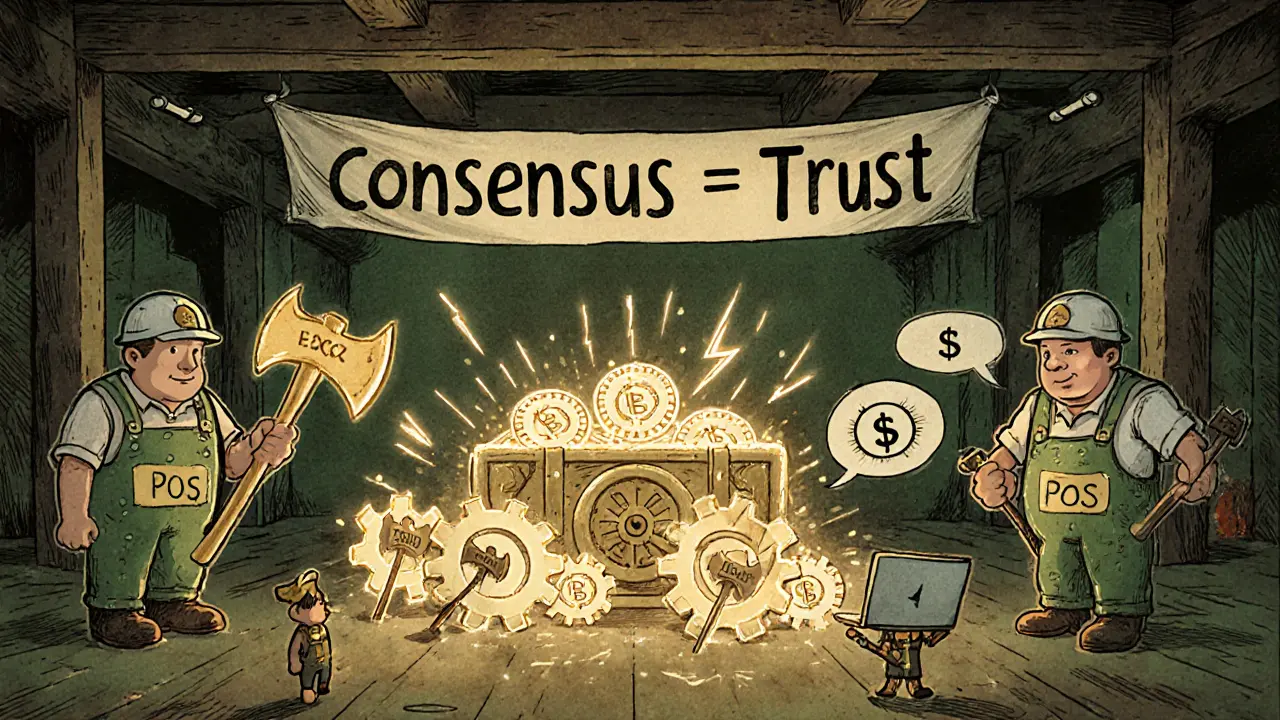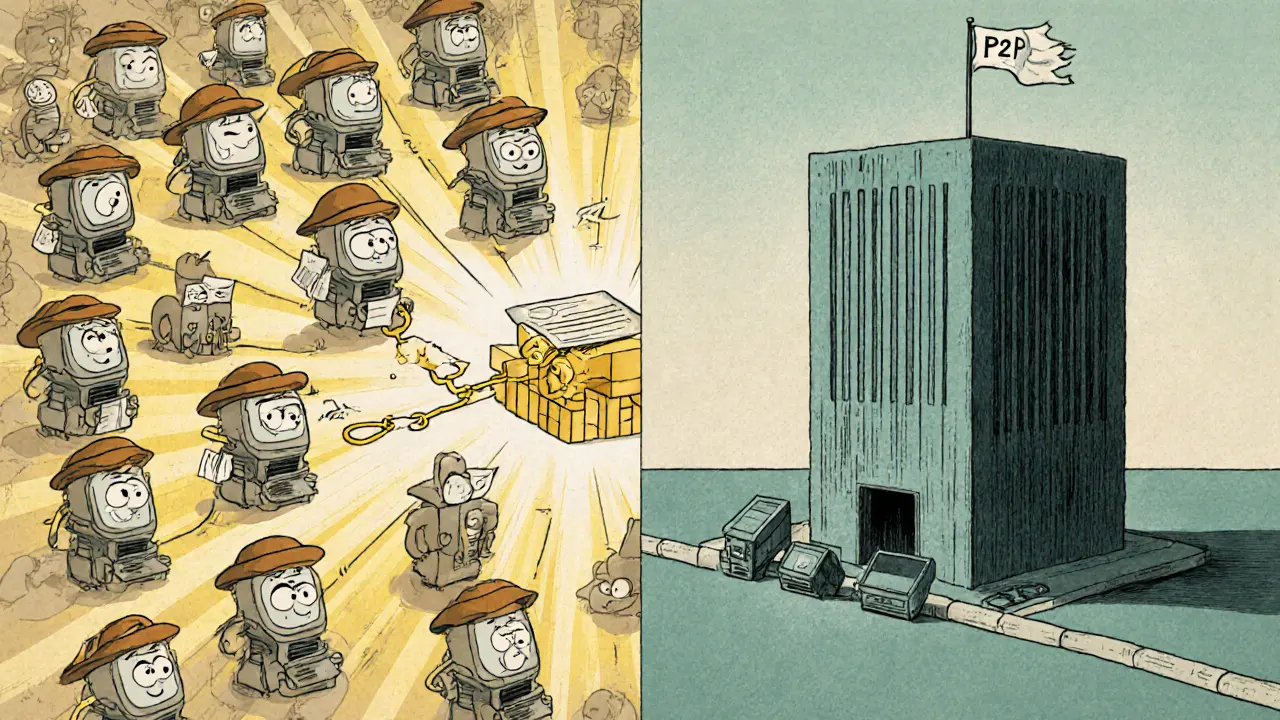P2P vs Client-Server Comparison Tool
Peer-to-Peer (P2P)
Used by blockchain networks where each node stores a copy of the ledger and participates in validation.
Client-Server
Traditional architecture where servers provide resources to clients, used in most web applications.
Select features and click Compare to see the key differences between P2P and Client-Server architectures.
Blockchain uses P2P because it provides decentralized control, high fault tolerance, shared cost distribution, and strong censorship resistance.
Key Takeaways
- Decentralization ensures no single point of failure P2P
- Shared cost model makes blockchain accessible P2P
- Censorship resistance through distributed control P2P
- Client-server easier for centralized apps Client-Server
When you hear the term blockchain is a distributed ledger that records transactions across many computers, the first thing most people picture is a network of peers talking directly to each other. That’s the essence of a peer-to-peer (P2P) networka decentralized system where each node acts as both client and server. In contrast, the classic client‑server architecturea model where dedicated servers provide resources to thin clients puts all the heavy lifting in a few machines. The question you’re probably asking is: why does blockchain cling to P2P while the rest of the web leans heavily on client‑server?
TL;DR
- P2P lets every blockchain node store and verify the ledger, removing a single point of failure.
- Client‑server is cheaper to manage for small apps but costs scale quickly with hardware and maintenance.
- Consensus algorithms (PoW, PoS, BFT) turn a chaotic P2P web into a trustworthy global state.
- Decentralization, censorship‑resistance, and open participation are the core philosophical drivers.
- Hybrid models exist, but pure P2P remains the backbone of public blockchains.
What makes P2P fundamentally different?
In a P2P setup, each participant-called a nodea computer that both sends and receives data in the network-stores a copy of the data it cares about. That means if you have ten nodes, you effectively have ten backups. The client‑server world flips that script: one or a few servers hold the master copy, and every client has to ask permission to read or write. Think of a library where every patron brings their own copy of every book (P2P) versus a single library building that everyone must visit (client‑server).
Cost distribution: who pays the bill?
Running a data center is expensive. You need racks, power, cooling, and a team to keep everything humming. That’s the price tag of the client‑server model-centralized, predictable, but heavy on capital. P2P spreads that cost across all participants. In blockchain, anyone with a spare laptop or a cloud VM can become a node, contributing storage, bandwidth, and CPU cycles. The network as a whole gets stronger without a single entity footing the bill. This cost‑sharing aligns perfectly with the permissionless ethos of most public blockchains: anyone can join, anyone can help secure the system.
Why decentralization matters for blockchain
Decentralization isn’t just a buzzword; it’s a safety net. Since no single server controls the ledger, there’s no obvious target for a hack, a government shutdown, or a corporate bankruptcy. The decentralizationthe distribution of authority and control across many independent participants principle gives blockchains their famous censorship resistance. If one node goes offline, the rest keep the chain alive and keep validating transactions. This redundancy is a direct benefit of the P2P layout.
Consensus: turning chaos into agreement
Here’s where the magic happens. A P2P network is inherently chaotic-every node can propose new data at any time. To avoid forks and double‑spends, blockchains layer a consensus mechanisman algorithm that lets distributed nodes agree on a single data history. Proof of Work (PoW) asks miners to solve a hard puzzle; Proof of Stake (PoS) lets validators lock up tokens as a safety deposit; Byzantine Fault Tolerant (BFT) protocols let a small set of known validators reach agreement quickly. These mechanisms make a P2P web behave like a single, trustworthy database without the need for a central authority.
Performance and scalability: myth vs reality
Traditional wisdom says P2P doesn’t scale-add too many peers and the network becomes noisy. Early BitTorrent files, for example, struggled once you passed a few dozen peers. Blockchains have tackled that head‑on. Distributed hash tables (DHTs) let nodes locate each other efficiently, while sharding splits the ledger into smaller pieces that can be processed in parallel. Layer‑2 solutions like Bitcoin’s Lightning Network or Ethereum’s rollups push most transactions off‑chain, letting the base P2P layer focus on security while scaling throughput dramatically.

Hybrid models: a middle ground?
Some projects blend the best of both worlds. They keep a small set of “bootstrap” servers for peer discovery-so new nodes can find each other quickly-but once connected, data flow stays pure P2P. This hybrid approach eases onboarding without sacrificing the core decentralization guarantee. Even large enterprises that use private blockchains often start with a light client‑server overlay for admin tasks, then let the ledger itself run on a P2P mesh.
Real‑world examples: Bitcoin and Ethereum
Bitcoin runs a full P2P network of over 10,000 active nodes worldwide. Each node holds the entire block history and validates new transactions using PoW. Ethereum follows a similar pattern but switched to PoS in 2022, cutting energy usage while keeping the P2P backbone. Both chains illustrate how a globally distributed set of peers can handle billions of dollars in daily transaction volume-proving that the P2P model isn’t just academic, it’s battle‑tested.
Security hurdles and how blockchain solves them
P2P networks historically suffer from attacks: Sybil attacks (one actor masquerading as many nodes), eclipse attacks (isolating a node), and spam flooding. Blockchain counters these with economic incentives. Mining or staking requires real resources-electricity, hardware, or capital-that make attacks costly. Cryptographic signatures guarantee that only the rightful owner can move funds. The combination of cryptography, incentives, and consensus turns an open P2P mesh into a hardened, trustless platform.
Future trends: AI, IoT, and beyond
The next wave may see billions of IoT devices joining P2P blockchains to record sensor data, automate payments, or verify provenance. AI models could run on top of decentralized compute markets, paying peers for the horsepower they provide. All of these scenarios rely on the same P2P foundation that lets anyone, anywhere, become part of the network.
Comparison table: P2P vs Client‑Server for blockchain use‑cases
| Aspect | P2P (Blockchain) | Client‑Server |
|---|---|---|
| Control | Distributed; no single authority | Centralized; server owner decides |
| Fault tolerance | High - redundancy across many nodes | Low - server outage halts service |
| Cost model | Shared; participants provide resources | Owner bears hardware, maintenance, staff |
| Scalability | Horizontal via consensus, sharding, layer‑2 | Vertical - add more servers, load balancers |
| Censorship resistance | Strong - no single point to block | Weak - server can block requests |
| Security model | Cryptographic + economic incentives | Access controls, firewalls, patches |
Bottom line
If you need a system that stays online even when parts of it disappear, that doesn’t answer to a single boss, and that can let strangers trade value without trusting each other, P2P is the only sensible choice. The client‑server model shines for apps where you control the environment-think SaaS dashboards or internal tools-but it can’t deliver the trust‑less guarantees that blockchain promises.
Frequently Asked Questions
Can a blockchain work with a client‑server backend?
Yes, many private or consortium blockchains run on a hybrid stack where a few managed servers host the ledger while still using P2P protocols for replication. The trade‑off is less decentralization but easier governance.
Why isn’t every app built on a P2P network?
Pure P2P adds complexity: you need consensus, cryptography, and mechanisms to handle malicious peers. For simple CRUD apps, a client‑server design is faster to develop and cheaper to operate.
What’s the biggest scalability challenge for P2P blockchains?
Processing every transaction on every node creates a bottleneck. Solutions like sharding, rollups, and sidechains aim to off‑load work while keeping the core layer secure.
How do consensus algorithms protect against Sybil attacks?
By making the cost of creating a new identity expensive. In PoW you need hardware and electricity; in PoS you must lock up tokens, both of which raise the price of a malicious takeover.
Is P2P more energy‑intensive than client‑server?
Only if the consensus mechanism is energy‑hungry, like Bitcoin’s PoW. PoS and newer BFT algorithms consume far less power, bringing P2P energy use close to that of a typical server farm.


Chris Hayes
September 26, 2025 AT 13:47When you compare P2P to client‑server, the decentralization benefit is the biggest driver for blockchains. Each node validates transactions, so there’s no single point of failure. This redundancy also improves fault tolerance compared to a single server cluster. The cost model shifts from centralized CAPEX to a shared operational expense across participants. Consensus algorithms like PoW or PoS turn that chaotic P2P mesh into a trustworthy ledger. In practice, this means anyone can join and help secure the network without paying a provider.
Aditya Raj Gontia
October 4, 2025 AT 02:21From a technocrat perspective, the protocol stack in a P2P blockchain includes DHTs, gossip protocols, and cryptographic primitives. This stack adds latency but guarantees eventual consistency across nodes. Client‑server architectures lack those layers, focusing instead on throughput and low latency for CRUD ops. The trade‑off is obvious: you get modularity and resilience with P2P, versus raw speed with central servers.
mannu kumar rajpoot
October 11, 2025 AT 14:56Look, the elite tech cabal doesn’t want you to understand why P2P is chosen – it keeps the power decentralized, away from their control. Every node is a tiny rebel, preventing any single authority from imposing censorship. If they could force a client‑server model, they’d lock down the ledger and monitor every transaction. The whole point of blockchain is to stay out of their surveillance grid.
Tilly Fluf
October 19, 2025 AT 03:30To add a note of appreciation, the P2P architecture indeed aligns with the principle of open participation. By distributing ledger copies, the system upholds resilience and fosters a global community of validators. This approach also embodies the spirit of collaborative governance that many of us value.
Darren R.
October 26, 2025 AT 16:04When it comes to blockchain design, the drama unfolds on two stages!!! First, the P2P network spreads the ledger like a gospel; second, the client‑server model merely pretends to be efficient!!! Yet the philosophical underpinnings scream decentralization, a true testament to freedom!!!
Hardik Kanzariya
November 3, 2025 AT 04:39Exactly, the P2P model empowers participants and reduces reliance on a single operator. It also spreads the operational costs, making entry barriers lower for newcomers. Keep in mind that this distribution can improve security when properly incentivized.
Shanthan Jogavajjala
November 10, 2025 AT 17:13Considering the network stack, P2P leverages gossip protocols for state propagation, whereas client‑server relies on direct request‑response calls. This difference impacts bandwidth utilization and latency, especially under high load. The trade‑off is clear: P2P offers robustness at the expense of real‑time performance.
Jack Fans
November 18, 2025 AT 05:47The hybrid approach some projects adopt-using bootstrap servers for peer discovery-provides a smoother onboarding experience. Once peers connect, the data flow reverts to pure P2P, preserving decentralization. This blends usability with the core blockchain ethos.